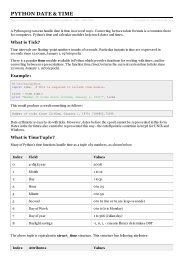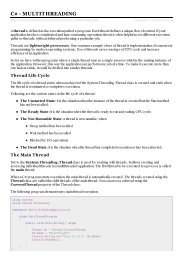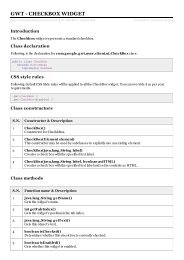Tutorials Point, Simply Easy Learning
Tutorials Point, Simply Easy Learning
Tutorials Point, Simply Easy Learning
Create successful ePaper yourself
Turn your PDF publications into a flip-book with our unique Google optimized e-Paper software.
20 | P a g e<br />
<strong>Tutorials</strong> <strong>Point</strong>, <strong>Simply</strong> <strong>Easy</strong> <strong>Learning</strong><br />
So use case diagram is used to describe the relationships among the functionalities and their<br />
internal/external controllers. These controllers are known as actors.<br />
Sequence Diagram:<br />
A sequence diagram is an interaction diagram. From the name it is clear that the diagram deals<br />
with some sequences, which are the sequence of messages flowing from one object to another.<br />
Interaction among the components of a system is very important from implementation and<br />
execution perspective.<br />
So Sequence diagram is used to visualize the sequence of calls in a system to perform a specific<br />
functionality.<br />
Collaboration Diagram:<br />
Collaboration diagram is another form of interaction diagram. It represents the structural<br />
organization of a system and the messages sent/received. Structural organization consists of<br />
objects and links.<br />
The purpose of collaboration diagram is similar to sequence diagram. But the specific purpose of<br />
collaboration diagram is to visualize the organization of objects and their interaction.<br />
Statechart Diagram:<br />
Any real time system is expected to be reacted by some kind of internal/external events. These<br />
events are responsible for state change of the system.<br />
Statechart diagram is used to represent the event driven state change of a system. It basically<br />
describes the state change of a class, interface etc.<br />
State chart diagram is used to visualize the reaction of a system by internal/external factors.<br />
Activity Diagram:<br />
Activity diagram describes the flow of control in a system. So it consists of activities and links.<br />
The flow can be sequential, concurrent or branched.<br />
Activities are nothing but the functions of a system. Numbers of activity diagrams are prepared<br />
to capture the entire flow in a system.<br />
Activity diagrams are used to visualize the flow of controls in a system. This is prepared to have<br />
an idea of how the system will work when executed.<br />
Note: Dynamic nature of a system is very difficult to capture. So UML has provided features to<br />
capture the dynamics of a system from different angles. Sequence diagrams and collaboration<br />
diagrams are isomorphic so they can be converted from one another without losing any<br />
information. This is also true for statechart and activity diagram.<br />
UML Class Diagram<br />
The class diagram is a static diagram. It represents the static view of an application. Class<br />
diagram is not only used for visualizing, describing and documenting different aspects of a<br />
system but also for constructing executable code of the software application.

















